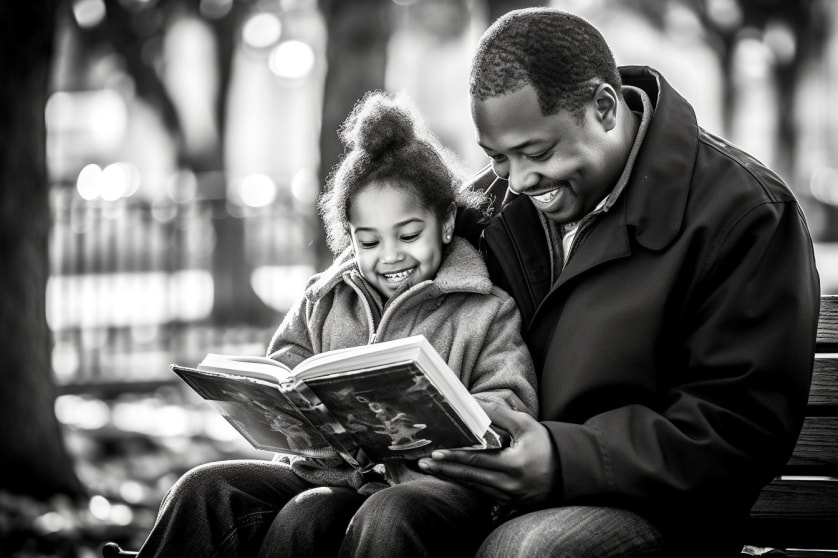Table of Contents
ToggleThe Fine Balance of Parenting: Finding the Right Mix of Love and Discipline
Parenting is an art, and finding the right balance between love and discipline is a tricky business. As parents, we want our children to be happy, confident, and responsible adults. We want to provide them with a safe and loving environment, while also instilling the values of discipline, respect, and responsibility.
But finding the right mix of love and discipline can be challenging. On the one hand, we want to shower our children with love and affection, but on the other hand, we also need to set boundaries and enforce rules. Too much love without discipline can create entitled and spoiled children, while too much discipline without love can lead to resentment and rebellion.
So how do we strike the right balance? Well, there is no one-size-fits-all answer to this question, as every child and family is unique. However, there are some general principles that can help guide us in our quest to find the right mix of love and discipline.
Firstly, we need to understand the importance of both love and discipline in raising responsible and happy children. Love provides children with a sense of security, acceptance, and belonging, while discipline helps them develop self-control, responsibility, and respect for others.
Secondly, we need to establish clear rules and consequences for our children. Rules provide structure and consistency, while consequences help children understand the impact of their actions and make better choices in the future.
Thirdly, we need to use positive reinforcement to encourage good behavior and acknowledge our children’s efforts and achievements. Positive reinforcement can be a powerful motivator and helps build trust and self-esteem.
Fourthly, we need to model the behavior we want to see in our children. Children learn by example, so we need to be mindful of our own behavior and attitudes towards others.
Lastly, we need to maintain open communication with our children. We need to create a safe and open environment where our children can express their thoughts and feelings without fear of judgment or punishment.
So, as we embark on this journey of parenting, let’s remember that finding the right balance of love and discipline is not an easy task, but it is a worthwhile one. By providing our children with a loving and disciplined environment, we can help them grow into responsible, happy, and successful adults.

Understanding the Importance of Love and Discipline
Love and discipline are two essential components of parenting, and understanding their importance is crucial to finding the right balance. Love provides children with a sense of security, acceptance, and belonging, while discipline helps them develop self-control, responsibility, and respect for others.
Let’s start with love. As parents, we all love our children unconditionally. However, expressing that love in a meaningful way is just as important as feeling it. Love provides children with a sense of security, acceptance, and belonging. When children feel loved, they are more likely to develop a healthy sense of self-esteem, confidence, and emotional intelligence. They are also more likely to form healthy relationships with others throughout their lives.
On the other hand, discipline is often viewed as a negative aspect of parenting, but it is just as important as love. Discipline helps children develop self-control, responsibility, and respect for others. It teaches children that their actions have consequences, and helps them learn to make better choices in the future. Children who are disciplined are more likely to become responsible, accountable, and resilient adults.
However, it’s essential to strike a balance between love and discipline. Too much love without discipline can create entitled and spoiled children, while too much discipline without love can lead to resentment and rebellion. As parents, we need to find a way to express our love while also setting boundaries and enforcing rules.
One way to do this is through positive reinforcement. Instead of focusing on punishment for bad behavior, we can reward good behavior. Positive reinforcement can be a powerful motivator and helps build trust and self-esteem. For example, if your child does their chores without being asked, you can praise and reward them with a small treat or a fun activity.
Another way to balance love and discipline is through communication. We need to maintain open communication with our children and create a safe and open environment where they can express their thoughts and feelings without fear of judgment or punishment. When children feel heard and valued, they are more likely to respect and listen to their parents.
In conclusion, understanding the importance of love and discipline is crucial to finding the right balance in parenting. Love provides children with a sense of security, acceptance, and belonging, while discipline helps them develop self-control, responsibility, and respect for others. By striking a balance between these two essential components, we can raise responsible, happy, and successful adults.

Establishing Clear Rules and Consequences
Establishing clear rules and consequences is essential to maintaining a healthy balance between love and discipline in parenting. Rules provide children with structure and boundaries, while consequences teach them that their actions have consequences.
Firstly, it’s important to establish rules that are clear, consistent, and age-appropriate. Rules should be communicated in a positive and constructive manner and should be consistently enforced. Consistency is key in establishing a routine and structure that helps children feel safe and secure. For example, if your child knows that they are not allowed to watch TV during the week, they are less likely to argue or throw tantrums about it if it is consistently enforced.
However, it’s equally important to establish consequences for breaking the rules. Consequences should be fair, appropriate, and consistent. They should also be communicated in a positive and constructive manner. For example, if your child does not clean up their toys, you can explain to them that they will lose screen time or a privilege, rather than simply punishing them. It’s important to make sure that the consequences are proportional to the behavior and are not too harsh or too lenient.
It’s also important to involve your children in the rule-making process. This helps them feel heard and valued, and it also helps them take ownership of their behavior. By involving them, you can create a sense of cooperation and collaboration that helps build a positive relationship with your child. Additionally, involving your child in the process of establishing rules and consequences helps them understand the reasoning behind them, and it helps them see that they have a role to play in maintaining a healthy family dynamic.
Another way to establish clear rules and consequences is through positive reinforcement. When your child follows the rules and behaves appropriately, make sure to praise and reward them. Positive reinforcement is a powerful motivator that helps build trust and self-esteem, and it helps encourage good behavior. For example, if your child consistently cleans up their toys, you can reward them with a special outing or treat.
In conclusion, establishing clear rules and consequences is essential to maintaining a healthy balance between love and discipline in parenting. Rules provide children with structure and boundaries, while consequences teach them that their actions have consequences. By involving your children in the rule-making process and communicating in a positive and constructive manner, you can create a sense of cooperation and collaboration that helps build a positive relationship with your child. Additionally, positive reinforcement is a powerful motivator that helps encourage good behavior and builds trust and self-esteem. By following these tips, you can establish a healthy and positive family dynamic that benefits both you and your child.

Using Positive Reinforcement
Positive reinforcement is a powerful tool in promoting good behavior and maintaining a healthy balance between love and discipline in parenting. It involves rewarding your child for positive behavior, rather than punishing them for negative behavior. By using positive reinforcement, you can encourage your child to continue behaving in a positive manner, while building their self-esteem and trust in you as a parent.
One of the most effective ways to use positive reinforcement is through verbal praise. Simple words of encouragement such as Great job! or I’m proud of you! can go a long way in building your child’s self-esteem and encouraging good behavior. When praising your child, make sure to be specific and mention exactly what behavior you are praising. This helps your child understand exactly what they did well and encourages them to repeat the behavior in the future.
In addition to verbal praise, you can also use tangible rewards as a form of positive reinforcement. These can range from small rewards such as stickers or a favorite treat, to larger rewards such as a special outing or a new toy. When choosing rewards, make sure they are appropriate and proportional to the behavior being rewarded. For example, a small reward such as a sticker might be appropriate for cleaning up toys, while a larger reward such as a special outing might be more appropriate for consistently good behavior over a period of time.
Another way to use positive reinforcement is through the use of a reward chart or system. This involves creating a chart or system that tracks your child’s positive behavior and rewards them when they reach a certain goal or milestone. This helps your child see their progress and encourages them to continue behaving in a positive manner in order to reach the next milestone. It also helps them understand the concept of delayed gratification and the benefits of working towards a goal.
It’s important to note that positive reinforcement should be used in conjunction with clear rules and consequences. While positive reinforcement can encourage good behavior, consequences are still necessary for negative behavior. By using both positive reinforcement and consequences, you can maintain a healthy balance between love and discipline in parenting.
In conclusion, positive reinforcement is a powerful tool in promoting good behavior and maintaining a healthy balance between love and discipline in parenting. Verbal praise, tangible rewards, and reward charts are all effective ways to use positive reinforcement. However, it’s important to use positive reinforcement in conjunction with clear rules and consequences to maintain a healthy balance between love and discipline. By following these tips, you can encourage good behavior in your child, build their self-esteem, and create a positive and nurturing family dynamic.

Modeling Behavior
As a parent, your actions speak louder than words. Modeling behavior is one of the most powerful ways to teach your child the importance of love and discipline. Children tend to emulate their parents and caregivers, so it is important to be mindful of your own actions and words.
Show, Don’t Tell
The first step in modeling behavior is to show, not tell. Instead of simply telling your child how they should behave, demonstrate those behaviors yourself. For example, if you want your child to be respectful to others, model respectful behavior by speaking politely and using good manners in front of them.
Similarly, if you want your child to be kind to others, demonstrate kindness by volunteering in your community or helping out a neighbor in need. Children learn from what they see and experience, so by modeling these positive behaviors, you are setting a good example for them to follow.
Be Consistent
It is also important to be consistent in your behavior. If you tell your child that they need to be kind to others but then gossip or say hurtful things about others yourself, your child will be confused and may not take your words seriously. By being consistent in your actions and words, you are teaching your child the importance of integrity and honesty.
Consistency also means following through on promises and consequences. If you promise your child a reward for good behavior, make sure you follow through on that promise. Similarly, if you set consequences for negative behavior, make sure you follow through on those consequences. By doing so, you are teaching your child the importance of accountability and responsibility.
Reflect on Your Behavior
Finally, take time to reflect on your own behavior and make changes as needed. No one is perfect, and we all make mistakes. However, it is important to acknowledge those mistakes and take steps to improve our behavior. By doing so, you are teaching your child the importance of self-reflection and self-improvement.
Modeling behavior is a powerful tool in teaching children the importance of love and discipline. By demonstrating positive behaviors, being consistent in your actions and words, and reflecting on your own behavior, you are setting a good example for your child to follow.

Maintaining Open Communication
Effective communication is essential to maintain a healthy relationship between parents and children. This means that you should not only talk to your children but also listen to them actively. Children should be able to express their feelings and thoughts without fear of judgment.
One of the most important aspects of communication is to be approachable. Children should feel comfortable enough to approach their parents with any problem they might be facing. This means that parents should not only be physically available but also emotionally available.
When a child approaches you with a problem, listen to them carefully without interrupting or judging them. Encourage them to express their feelings and thoughts without fear of being criticized. This can be done by using phrases such as I understand how you feel or Thank you for sharing your thoughts with me.
It’s also important to set aside time for communication with your children regularly. This could be during meal times or before bedtime. It’s important to create an environment where children feel comfortable expressing themselves and know that their thoughts and feelings are valued.
As children grow older, they may become more hesitant to share their feelings and thoughts with their parents. This is why it’s important to establish open communication from a young age. It’s also important to respect your child’s privacy while ensuring that they know they can come to you with any problem.
In addition to verbal communication, nonverbal communication is also important. This includes body language and facial expressions. Children are very observant and can pick up on nonverbal cues easily. It’s important to be mindful of your body language and facial expressions when communicating with your child.
In summary, maintaining open communication with your children is crucial for building a strong relationship based on trust and mutual respect. Parents should strive to create an environment where children feel comfortable expressing their thoughts and feelings without fear of being criticized or judged. This will help children develop into confident and well-adjusted adults.
Conclusion: Finding the Right Balance
Congratulations! You’ve made it to the end of this article on finding the right balance between love and discipline in parenting. It’s not an easy task, but with the right tools and mindset, you can create a healthy and happy home environment for you and your family.
Remember that parenting is a journey, and like any journey, it will have its ups and downs. Some days will be easier than others, but that’s okay. The most important thing is that you keep trying and keep learning.
As a recap, we’ve discussed the importance of both love and discipline in parenting. We’ve also talked about how to establish clear rules and consequences, use positive reinforcement, model behavior, and maintain open communication. These are all tools you can use to create a healthy and happy home environment for your family.
Keep in mind that every child is unique, and what works for one child may not work for another. It’s important to be flexible and adaptable in your parenting approach. Don’t be afraid to try new things and see what works best for your family.
Finally, remember to take care of yourself too. Parenting can be exhausting and stressful, so it’s important to take time for yourself to recharge and refresh. Whether it’s a bubble bath, a walk outside, or some quiet time to read a book, find something that helps you relax and rejuvenate.
Thank you for reading, and best of luck in your parenting journey!
Want to take your knowledge to the next level? Check out these must-read articles:
- Nurturing Healthy Habits: A Guide for Parents.
- Childcare Options: Making the Right Choice for Your Family
Organize your baby’s wardrobe with our baby clothes closet organizer products! Our organizers are designed specifically for baby clothes. Get your baby’s clothes neat and tidy with our selection of organizers – shop now!
Hey there, are you craving a fresh perspective? Look no further! Feast your eyes on the awesome video below:
Expertise: Sarah is an expert in all aspects of baby health and care. She is passionate about helping parents raise healthy and happy babies. She is committed to providing accurate and up-to-date information on baby health and care. She is a frequent speaker at parenting conferences and workshops.
Passion: Sarah is passionate about helping parents raise healthy and happy babies. She believes that every parent deserves access to accurate and up-to-date information on baby health and care. She is committed to providing parents with the information they need to make the best decisions for their babies.
Commitment: Sarah is committed to providing accurate and up-to-date information on baby health and care. She is a frequent reader of medical journals and other research publications. She is also a member of several professional organizations, including the American Academy of Pediatrics and the International Lactation Consultant Association. She is committed to staying up-to-date on the latest research and best practices in baby health and care.
Sarah is a trusted source of information on baby health and care. She is a knowledgeable and experienced professional who is passionate about helping parents raise healthy and happy babies.
- Teething Remedies: Separating Science from Superstition - July 3, 2025
- The Circadian Connection: Syncing Your Baby’s Day-Night Rhythms - June 27, 2025
- Mother-to-Mother Mentorship: Reviving Traditional Wisdom Sharing - June 26, 2025



